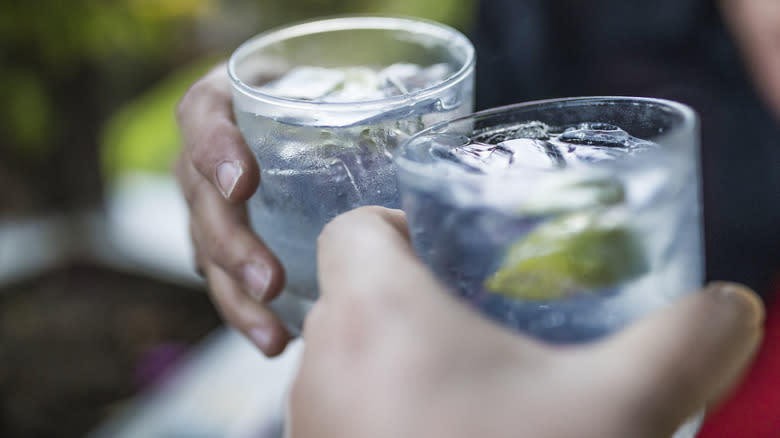What Exactly Goes Into A Gin And Tonic Cake?

If you love sipping on gin and tonics on a night out, the idea of a gin and tonic cake might perk up your ears. And, as you can probably guess by the name, a gin and tonic cake is a cake that gives a nod to the classic cocktail. It features both gin and tonic in the recipe to emulate a traditional G&T.
Of course, these are far from the only ingredients featured in a gin and tonic cake. Aside from the standard flour, sugar, butter, and other components needed to bake a cake, gin and tonic cake also features lime juice and/or zest. Depending on the recipe you use, the cake may contain juniper berries as well (juniper is one of the core ingredients in gin).
If you're into the G&T drink, you'll enjoy its edible counterpart. Take a more in-depth look at what goes into a gin and tonic cake so you can make one yourself.
Read more: Cake Hacks Every Baker Will Wish They Knew Sooner
How Gin And Tonic Cake Gets Its Flavor

Gin and tonic cakes feature gin and tonic as two of the main flavorings. Interestingly enough, however, there's actually not a huge amount of either of these ingredients in the cake. Depending on the recipe, you might only use around 2 ½ ounces of gin in the cake. And, for the tonic, you'll be looking at using roughly ½ cup.
However, the reason these ingredients are so noticeable in the cake is that they don't just go into the cake batter. To really give the cake the flavors of both of these ingredients, you'll use them to make a tasty syrup. Then, sort of like with a poke cake, you'll poke holes in your cake base and pour the gin and tonic syrup into the cake to infuse it with flavor. Steeping juniper berries into the syrup can reinforce the taste of the gin.
Gin and tonic cake will also sometimes get an extra hint of flavor from buttercream frosting. Some recipes call for a few more tablespoons of gin and tonic to be added to the frosting. This can help ramp up the already bright flavors of the cake and really bring out the gin and tonic taste.
The History Of The Gin And Tonic Combination

Although there's little information available about who came up with the idea for the gin and tonic cake, we know quite a bit about where the gin and tonic drink combination came from. The origins of this particular drink date back to the 1800s in India, when British soldiers used it as a cure or preventative measure for malaria. Tonic water contains quinine, which is a known malaria treatment, making it a seemingly good candidate for staving off this nasty disease.
In the later half of the 1800s, the drink rose in popularity as more of a refreshment. English colonists in South Asia, in particular, turned gin and tonic into a popular afternoon drink for cooling down under the hot sun.
As the drink rose in popularity, variations on the classic recipe also began to crop up. Each of these variations plays around with things like the garnish for your gin and tonic, the glassware, and the ingredients. Today, whether you enjoy your gin and tonic as a drink or in a cake, it's a tasty flavor combination that people relish around the world.
Read the original article on Daily Meal.

